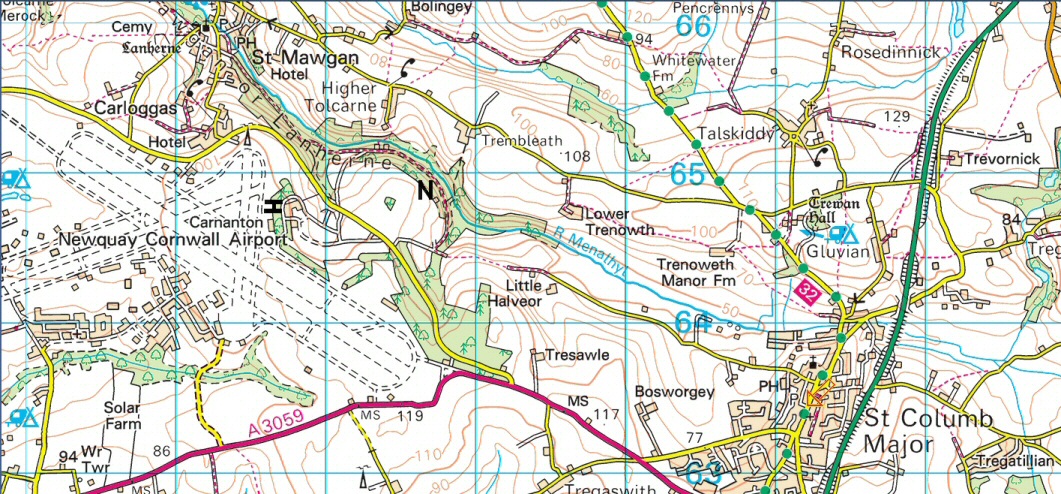
Nankivell -- information about the name and variants
You could also visit https://en.wikipedia.org/wiki/Nankivell
Nankivell, Nanskevell, Nanskeval, Nanskival, Nansceval, Nanscuval
Even Nankervis. We are told that all these name variants are all taken from one place-name
in the Cornish parish of St Mawgan Pydar.
All these names are derived from the Cornish word "Nans" meaning "Valley" and the "personal name Cuvel"
And significantly St Mawgan-in-Pydar is a mere four miles from Saint Columb Major - why? Read on !
Its church is dedicated to St Mauganus; a Welshman who is also honoured at Mawgan in Meneage in Kerrier
(the most southerly tip of Cornwall - the Lizard) and also in Wales and Brittany
Apparently one person, way back when, liked to spell it Nankyvell !!
Please read on, and near the end do play those calypsos !
We are told that Cornish surnames are characterised by a multiple spelling variations.
This is put down to the fact that early and middle English lacked spelling rules. But also,
church officials at christenings, marriages etc sometimes wrote down the name just as it sounded to them.
In the 1891 census there were 87 Nankivell families living in Cornwall, which was 37% of all recorded Nankivells in the UK.
This 1891 census tells us that Cornwall (Kernow) was the county with the highest population of Nankivell families.
Here is information on the origin of these closely related versions:
The Nankivell name's meaning is given here below - and more - much more !
Last update 14th April 2021
Our earliest known Nankivell ancester is Odo de Nanscuval - which means "Odo of the place which has the name Nanscuval"
An early Cornish written-record has it that, in the year 1324
"Lands at St Columb Major were granted to Odoni de Nanscuvel and his wife Rosee".
Of course "de" is the French word meaning "of"
So we got our surname from a piece of land - a normal procedure of around those times.
In our case the piece of land is near the Cornwall town Saint Columb Major
Another record - of circa 1440 A.D. - tells us of a certain Typett Nanskevell of Saint Columb Major - so our name is evolving.
A direct descendant "John Nanskevall alias Typpett of St Columb Major" was born 1470 and died after 1500.
Now this John Nanskevall had four sons who were all surnamed Nankevill
The eldest, Marke Nankevill alias Typpett of St Columb Major, had three grandsons
all surnamed Nankivell born 1580 and soonafter - so our surname Nankivell
continued from then on, having finished evolving.
The Cornish motto is "ONEN HAG OLL" which means "One and All"
Which
also means "Cornwall is for all of us" hinting that some Cornish people
believe Cornwall is a nation,
which it was, from the removal of the Romans up to the year 901 when it agreed to become part of the kingdom of Wessex.
For
centuries Cornwall still kept its own culture. Cornwall still calls itself
Kernow - the "wall" part of "Cornwall", like "Wales", comes from the Anglo-Saxon word
"Wealas", meaning "foreigner".
King Edgar (956-975) of Anglo-Saxon England, styled himself as "King of the English and ruler of the adjacent nations"
Saint Columb Major, or Saint Columb the Greater as it was known in ancient times,
was big enough to be granted a market in 1333 by King Edward III
Some say it was founded in the 6th century by Saint Columban, who came to Cornwall from Ireland to convert
the pagan Celts both in Cornwall and then in Brittany
In France at the heart of Guyenne in the Aquitaine there is a village called "Saint-Colomb-de-Lauzun" 600Km south of Paris.
We learn it was founded in 580 AD by Saint Columban.
We are told that this saint arrived in France from Ireland with 12 companions on an evangelising tour of Europe
This website was
prepared and is built and occasionally added to by Edmund Typpett
Nankivell (born1936)
whose grandfather Edmund and all his known antecedents were born in Cornwall,
Grandfather Edmund Nankivell grew up
in the house in St Columb Major called Penmellyn
before joining the Royal Navy.
There are three
pieces of
evidence pointing to Nanskeval and its variants (including Nanscuval)
being a small area of land just outside the western
parish-boundary of Cornwall's St Columb Major.
But first, the
meaning of the
name ‘Nankivell’.
The oft-quoted suggestion that it means “Valley of
the Horse”
is unacceptible because ‘Horse’ in Cornish is ‘Margh’
What Edmund regards as this falsehood appears in T F G
Dexter's 1926 book "Cornish Names - an attempt to explain over 1600
Cornish names"
where "Nanskeval"
is said to mean "Valley of Horse
(cevil)". But the Edmund Nankivell Jr research finds that while cevil is close to Wesh Celtic
for horse
(which is ceffyl) it is nothing like
the Cornish Celtic for horse which is margh.
The genealogist who
prepared
the very detailed genealogy of the name Nankivell for my father Howard Noel Nankivell back in
the
1920s,
stated the name means “ Valley
of the Woodcock”.
As the Cornish Celtic word for ‘Woodcock’ is ‘Keveleg’ this is very plausible. And of course Nan, Nans and Nance mean “Valley”.
There are many hundreds of Nankivells listed on this wikitree genealogy website htpps://www.wikitree.com/genealogy/NANKIVELL.
Many from Cornwall, Devon, Australia and New Zealand.
The Cornish
language (Kernewek) is not dead eben though the last Cornish speaker
with no English was a woman called Chesten Marchant who died in 1676; a
woman called Dolly Pentreath who died in 1777 also a fluent natural
Cornish speaker. Fluent users of Cornish as well as English continued
right through to the late 1890s. Nevertheless the 'Cornish Language Partnership' website reported in 2010
that there are around 300 fluent Cornish speakers who use Cornish
regularly, with about 5000 Cornish people who have a basic
converstional ability in the language. In 2018 we learn that 77
people passed the Cornish Language Board exam, an increae of 15% over 2017.
This rise is thought to be due to the success of the Welsh/Cornish
singer Gwenno Saunders (she grew up in a Cornish-language-speaking
family) who in 2018 released her first album in Cornish entitled "Le Kov"
(meaning a "Place of Memory" in Cornish) with English-language subtitles.
In the
2011 UK Census, 273 people in Cornwall listed Cornish as their first
language. More here. on this cornwall.gov.uk website
Now, here is a quote from the book Vale of Lanherne, which was actually written in 1903 by Charles Lee when
he was the organist at St Mawgan church:–
He quotes the
words of “the local bard” as follows:– “You may search in and
out, you may hunt up and down, but you won’t find an equal to Mawgan
Churchtown. Lanvean and PolgreenTolcarne
and Trevedras.
Lanherne and Nanskival and Gluvian and Deerpark.
Trevarrian,
Tregurran, Trevena, Carloggas, Trenoon and Bolingey
and Mawgan Churchtown”.
All underlined names have been located and are
close to
St Mawgan, implying Nanskival is similarly a place near St Mawgan.
Trenoon was very near St Mawgan as a report about the construction
of the
airfield south of St Mawgan (sometimes called Carnanton Airfield)
states
that it “engulfed Trenoon”. It would also have engulfed Deerpark.
And on Page 40 of this book there are two metions of "Nanskival" where
ithe book has this:- "...Nanskival - which in the old Cornish language means
Woodcock Valley..." and
Another
authority tells us that the wild bird Woodcock, in no less than six sub-species,
was common in this very region although rare elsewhere in Cornwall.
Arthur
Jewer's 1881 book book "The Registers of St
Columb Major, Cornwall - 1539 to 1780" tells us that "The
name Nankivell is pure Keltic, and means the 'Glen of the Woodcock' a
glen so-called (generally spelled Nanskevall), with its fine old oak
wood, lies about two miles from St. Columb".
But the actual spellings of births marriages and deaths are Nankevell,
Nankevall, Nancekevell, Nanskeval, Nanscavoll before settling, before 1780, on
Nankivell.
But there are spelling errors as in "John Nankevell &
Jane his wiffe" with "wife" spelled correctly elsewhere. There is also
"Alice Nankevall, wydow".
Moreover in Charles Lee's 1903-compiled
book "The Vale of
Lanherne - Past
and Present" the author takes a path through the Tolcane Hamlet then
behind the ruined Lawry's Mill to Nanskival - and the author continues
"which in the old language means Woodcock Valley". See below a picture
of Lawry's mill.
Another piece of evidence of where Nankivells come from is the map found on
Page 44 of the hardback “The Book of St
Columb and St Mawgan”
which shows “A Plan of Carnanton with Nanskivell".
This is from
Carnanton Estate Records.
Now Carnanton Manor is close to St Mawgan
and about
2 to 3 miles West of St Columb Major, so very much in the region of interest.
In the recent map shown here, symbols added are N = Nanscuval (Nanskival etc)
whilst the horizontal "H" is Carnanton Manor House
- as it looks like that from the air.

More good evidence of the existence of Nanskival as
a place, however small a place, is a
reference dated 2011 about the St Columb Major’s Townsmen v.
Countrymen Hurling Match that year:–
For more on Cornish hurling go to:- https://en.wikipedia.org/wiki/Cornish_hurling
To
win, a contestant had to get the silver ball to one of two goals. One
goal is a mile from the Market Square start,
the other goal is to get
the silver ball over the parish boundary anywhere.
In 2011 the Townsmen won, when a townsman got the silver ball just
over/outside the
parish boundary..
Here is the important quote regarding this 2011 event:- "Sean Johns...broke
away
and led the chasing pack down to the parish boundary at Nanskival".
Another authority has this highly relevant information, here quoted:–
"The Carnanton
Estate included
the ancient Nanskeval House which is recorded in 1277 as Nanscuvel. It
is
thought that the surname of Nankivell and its variants derives from
here. Nans means
"valley" in Cornish. It has been proposed that Kivell may
derive from an extinct Celtic word for "horse" (as there is a similar
word in Welsh, though margh is the Cornish word for
horse).
Alternatively, the Cornish word kevelek for Woodcock
has been
suggested, which would be highly compatible with the wooded river
valley in
which pheasants thrive today. It's also possible that Cuval or Kevall
was
simply someone's name".
Also - there is a Landscape document by www.cornwall.gov.uk which
is dated 2012 by Parsons Brinkerhoff.
It refers (in paragraphs
7.4.6, 7.4.7, 7.5.1 7.5.17 & 7.5.20) to
Nanskeval Woods in the Carnanton Estate.
In Victorian times,
Nanskeval
House was the home of Edward Brydges Willyams (1831-1916), three times
Liberal MP (MP twice for Truro, once for East Cornwall), who in 1892
was appointed 'High
Sherriff of
Cornwall'. He was a keen supporter of Cornish Hurling (Hurlian in Cornish); in 1916 he died in
Carnanton Manor.
It
was said that the owner of Nanskeval House played cards with the
newcomers, the Willyams, at Carnanton and lost his ownership of the
esate due to gambling losses. We are told that the Estate, as of
2018, is
still
owned by descendants of the same family.
Nanskeval
House became a Guest-House in the 1960s, run by a the fairly elderly
Irish couple Mr & Mrs Pedlar.
There were 27 bed-rooms, a large
entrance hall and a wide sweeping staircase. Mr Pedlar
worked on the local farm land
- as remembered by a couple and their
family that stayed in Nanskeval House four or five times in the late 1960s and early 1970s - they described a
wide sweeping driveway, stone steps leading up to the house with two
stone pillars with big stone spheres on their tops (see photo
below). There was a young girl who helped Mrs Pedlar with cooking and
serving the meals - she must have lived nearby as she walked to and
from the house, so it may even be that she lived at Nanskeval Cottage.
For
the guests, it was only a short stroll through the woods to a pub in
St
Mawgan. The farm had a dairy herd - the dairy was in a small building
which was originally a chapel, which survived the distruction of the
Nanskeval House.
But Nanskeval
House suffered from dry rot and other age-related problems, and the
Pedlars closed it down and either died there or returned to Ireland, so it
then became empty and was demolished in 1975 - for more, see below.
Here is a relevant comment on Nanskeval House:- The towns-folk in St Columb Major were not so happy with the demolition since it had been marked as a heritage listed property. The owner, the now deceased resident at Carnanton Manor, apparently thought very little of this and went in on a weekend and bulldozed the buildings.
This reference, below, to Nanskeval Cottage was found on the internet:-
Nankeval Cottage. St Mawgan TR8 4EB Latitude N=50.445 degrees, Longitude W=4.97689 degrees.
This is dead right !! Been there in 2008 !!! Photographed it !!!!
And here - below - are the 2018 photos of Nanskeval Cottage -
it looks quite nice from
the front but somewhat rough at the back - maybe it was still habitable.
worked at Nanskeval House
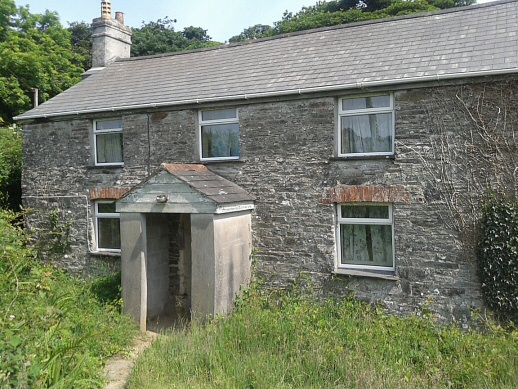 |
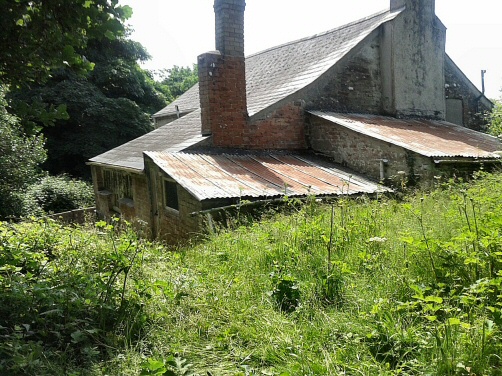 |
In January 1950 Norah Jaggers and her family stayed there while Mr Jaggers worked as a gardener on the Carnanton Estate.
They
left in 1955. Norah reported it was known as the "Dower House" for
Nanskeval which was then effectively the Home Farm for the estate.
Norah tells us the cottage had a reception room on both sides of the
entrance-hall, and the kitchen was along the back. The single-storey
extension at the back was the dining room; there were three bedrooms
upstairs.
The water supply came from a spring higher up in the
woods, which fed a tank just outside the kitchen. A hand-pump was used
to pump water from it into the water-tank in the attic.
The farmer was then a man called Roland Pedlar.
In 2018 Edmund Nankivell Jr saw the cottage - somewhat close to
where
the Nanskeval House once was -
looking fairly nice at the front but somewhat rough at the sides and back.
When Nanskeval House was inhabited, this cottage was lived in by the gardener and his family for the Carnanton Estate.
Here - below - is
the Nanskeval House before its demolition in 1975. Clearly in the Glen of
the Woodcocks !!
The centre part of the house is the original building,
probably of pre-Victorian construction.
It had no less than
27 bedrooms but suffered from dry rot. Nanskeval House was on the
parish boundaries of St Mawgan in Pydar and St Columb Major. Nankeval
House was once the home of Liberal MP Edward Brydges Willyams (1834 -1916) who in 1892 became High Sheriff of Cornwall -
desendants of the same family were still owning Carnanton Estate (in 2020) where the
house was and the cottage still is.
The then-owner of
Carnaton Manor wanted it gone so, one weekend in 1975, the buldozers went in and
down came the ruin.
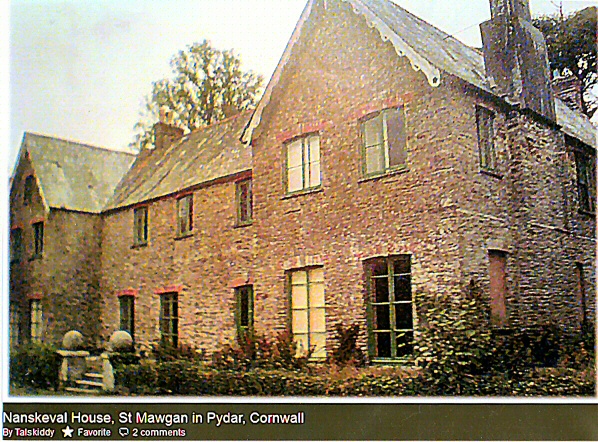 |
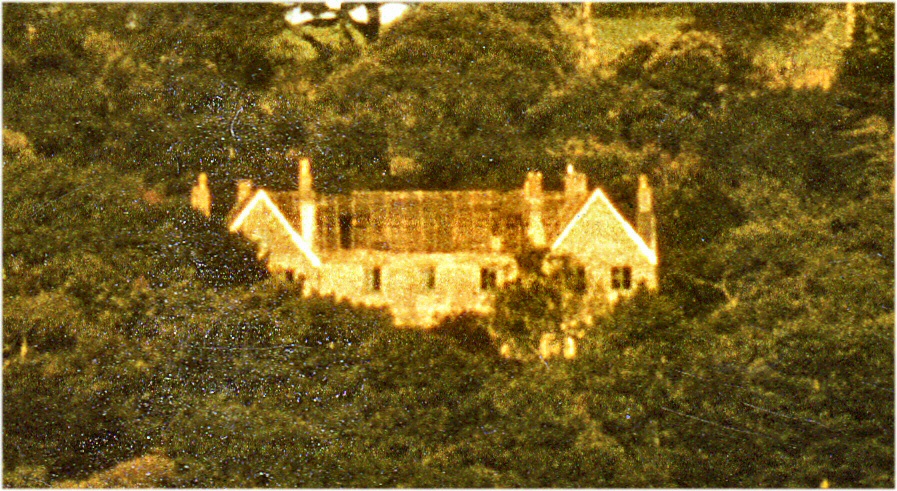 |
As the crow
flies, not more than a kilometre from
Nanskeval Cottage, was "Lawry's Mill" a water-mill so-called because it
was lived-in and operated by the Lawry family certainly back in the
1800s. It was Mrs Old living in Lawry's Mill in the 1950s.
Authorities list it as "based in Nanscuval" and it "worked on the river
Menalhyl" (where else !!).
Some authorities even named it the "Nankivell Mill"
Here below is a
period photo of it showing its white-washed house on the left, the
grey-roofed mill-house in the centre,
and its mill-wheel on the right, the date of photo is reckoned to be
1820 - 1830. It was coloured later.
It was still there in 1903 named as "Lawrey's Mill" with cream teas then
available, and maybe as late as 1980
(but cream teas no longer
served) as a photo of it appears in Charles Lee's book written in 1903 but not published until 1984
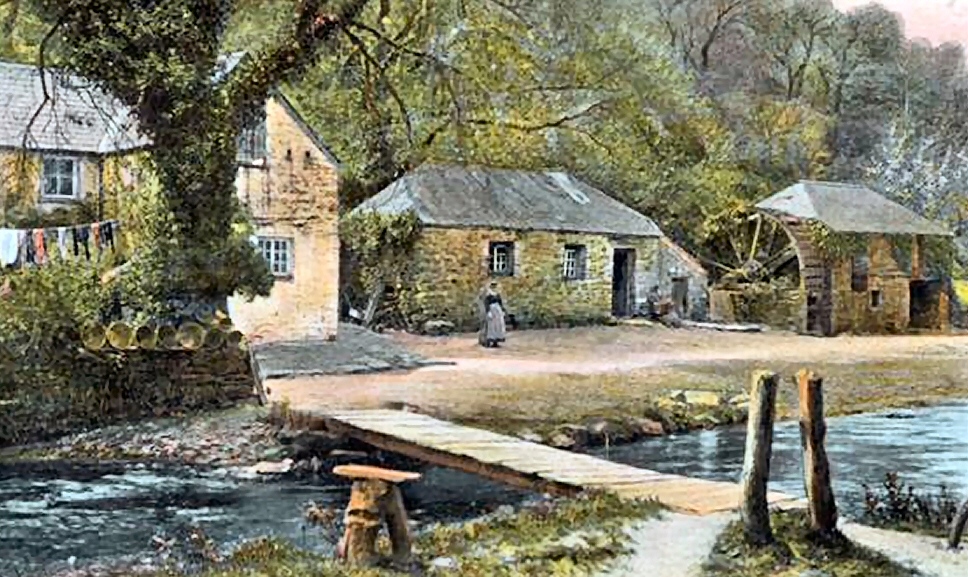
To slightly change the subject, to
read Doug and Joan Mumma's very interesting and relevant Nankivell News
Edmund Nankivell senior was the last Nankivell in my direct line to have been
born in Cornwall. He
was born on 16 July 1844 and grew up at Penmellyn House, Lower East
Street, St Columb Major. The architect-designed "Penmellyn" (a Grade II Listed Building) means
"House with the view of a mill" as it was built on high ground
overlooking the Menalhyl River (yes !!) in the valley below where there was a working
water mill - now fully restored. Penmellyn was built c. 1855 or earlier
and this Edmund's
father, Dr John Hicks Nankivell (1809 to 1888) is said by our
professional genealogist to be "of Penmellyn". So it looks as if he had
it built, and his son Edmund would have been aged about 10 or 11 when
they moved in.
Centre - Edmund Nankivell RN
Right - Penmellyn House in 2016
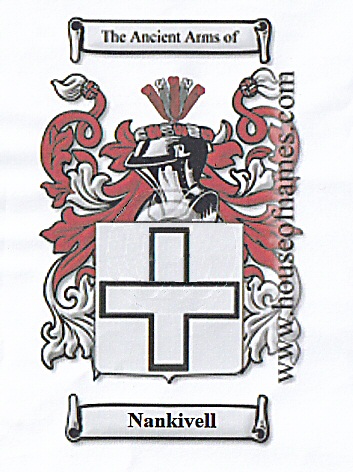 |
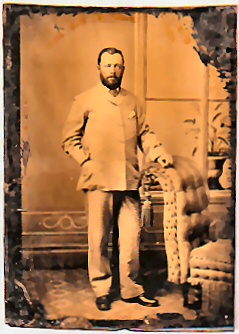 |
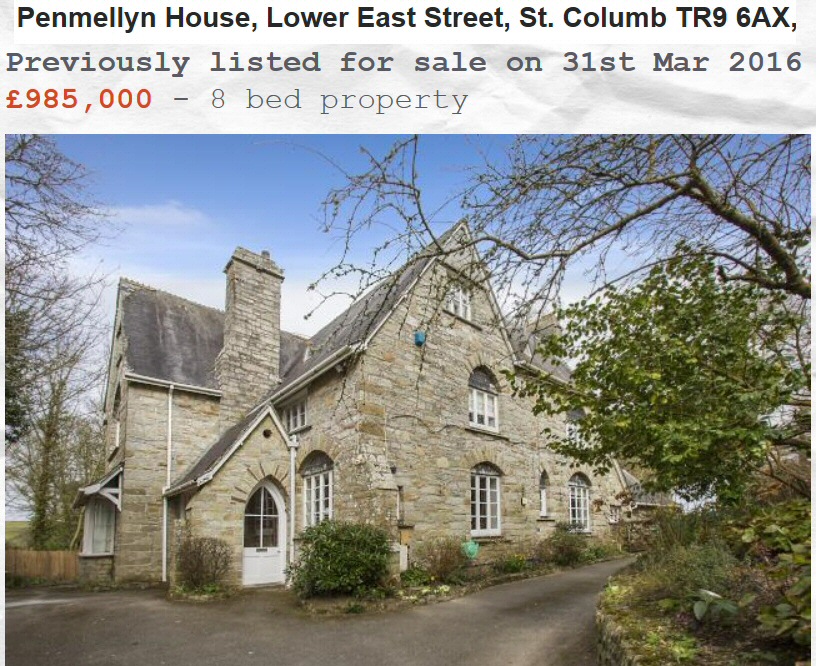 |
Here is a photo of rescued slaves on Edmund Nankivell Sr's ship:-
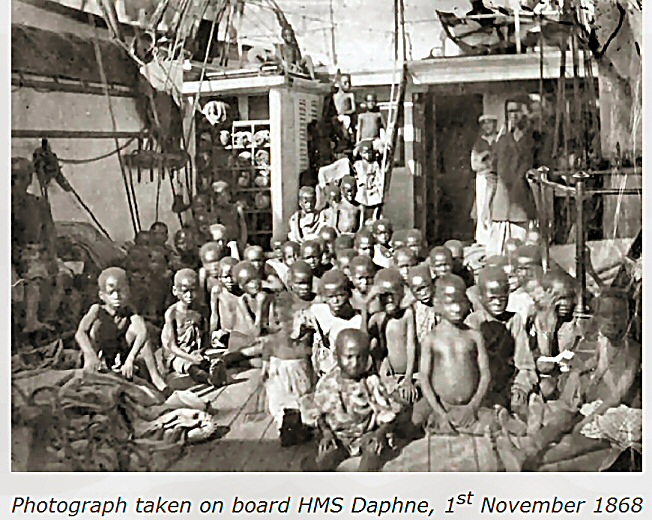
By
22/11/1877 Edmund Nankivell Sr had moved to, and settled in, Jamaica because the Arab Moslems,
to avoid the Royal
Navy, in order to continue moving their slaves to Arabia had
switched to land-routes.
So
there was no longer any navigating for Edmund Nankivell Sr to do off the East Coast of Africa.
In Jamaica he documented (published 1882) all the several harbour systems, with information on how sailing ships fo that time should navigate in and out of these Jamaican harbours - most Jamaican harbours were in river estuaries.
Then in
1883 he published "Jamaica and
the Panama Canal" as work had
started on the construction of the Panama Canal in January 1882
mostly using Afro West Indian Labour. No doubt much coming from Jamaica.
On
the 25th October 1882 - in Jamaica - he married
Lilla Agnes Norton,
who had been a child escapee from the USA's civil war (which had run from 1861 to 1865).
His
daughter
Kathleen Lilla Maud Nankivell was
born 6th December 1884 in Jamaica and my father
Howard Noel Nankivell was born in Jamaica on 27th March 1893.
Edmund
Nankivell RN died on the 17th April 1895 in Jamaica, aged 50 years 9
months when the then-incurable Bright’s Disease
(kidney disease) took him away.
Here
is a photo taken in Trinidad c. 1935 of Howard Noel Nankivell and his
new wife Florence Nankivell
(maiden name Muysken).
Their daughter Selma was born in Trinidad.
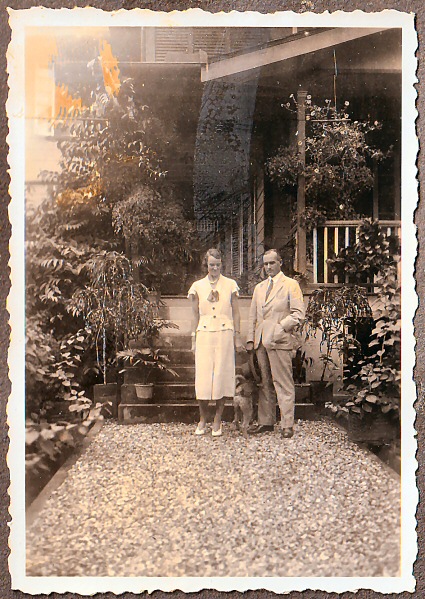
Howard Nankivell's splendid ahead-of-his-time efforts to improve the lot of Trinidad's locals is well covered in this book
by Trinidad historian Brinsley Samaroo.
The book The Price of Concience
is a very good read, an accurate account of what happened - and what
should have happened - in Trinidad during Howard Nankivell's period
there. It is ISBN 978-1-910553-04-6 published by Hansib.
Get it ! Have a read !
Late
in 1938 Florence Nankivell did a superb thing - she bravely
masterminded, arranged and accompanied back from Berlin the very first Kindertransport
train (more here: https://en.wikipedia.org/wiki/Kindertransport), of Jewish children allowed to leave Nazi Germany for Britain; it
arrived in Harwich on 3/12/1938 with 200 children -
just nine months before war
broke out, and just a very few days after Kristallnacht. This was the pioneering Kindertransport.
Very many of the children were Jewish orphans as the Nazis had just destroyed their orphanage.
Florence also took part in arranging in Britain foster parents for the children; most but not all went to Jewish homes.
She was very willing to do the second Kindertransport train, but her handlers thought it too dangerous for her.
In the 1950s Florence, living in Cornwall, became involved in
archeology and was heavily involved in the
West Cornwall Field Club.
She organised their digs in West Cornwall and always took part in them.
One dig was at Bodrifty in West Cornwall. It was basically a circle of Iron Age hut foundations.
Edmund Jr was there in its 2nd year - tasked with cleaning (de-weeding) a hut circle, so it could be photographed.
He found a tiny piece of pottery just projecting through the compressed-earth Iron Age flooring.
It turned out to be the bottom half of a Bronze-age pot! A major find
as it showed that the Iron Age folk had found and inhabited a much older Bronze Age establishment!
In 1961 the West Cornwall Field Club evolved into the Cornwall Archaeological Society
and Florence was its first secretary; for 10 years she worked hard to get it to be a greatly enlarged organisation
and a very important one - as it always will be.
Her life is an example that women can do just as important, valuable things as men, and what a waste of talent when they were not seen as belonging anywhere outside the kitchen or the baby's nursery
Edmund
Typpett Nankivell (Edmund Jr) the author of this website was conceived in Trinidad
but born in the Netherlands,
although spending a couple of years or more in
Trinidad when very young.
During
the
years 1937-1938: Edmund's farther Howard Nankivell, when Trinidad's Colonial Secretary, attacked the way
British big business in Trinidad was exploiting their workers, giving
them a seriously
hard and unhealthy life - famously once in an attacking speech to
Trinidad's Legislative Council. Powerful business interests back in London did
not like that one
little bit so they forced Britain's then Colonial Secretary, at that
time a supporter of Nankivell and the very good work he was
doing, to
remove him from Trinidad and down-grade him to Treasurer of Cyprus,
then of course also still a British colony.
After
3 months in the pen-pushing post (he described it) of Treasurer he set out from Cyprus to return to England for
Christmas 1938 to be with his family.
This was by boat from Cyprus to Italy then train
from Italy via Switzerland and France to Britain
But
on 21/12/1938 he was found dead by the railway track in France near St
Florentin, fairly close to, but before arriving in Paris, and he is
buried at the cemetary in St-Germain-en-Laye near Paris.
Howard
Noel Nankivell is still revered in Trinidad. As of 2020, Trinidad singer
Attila The Hun's Calypso
"Mr Nankivell's Speech" is still available on the
internet
Howard Nankivell's grave in France has been renovated, to the delight of some people in
Trinidad !
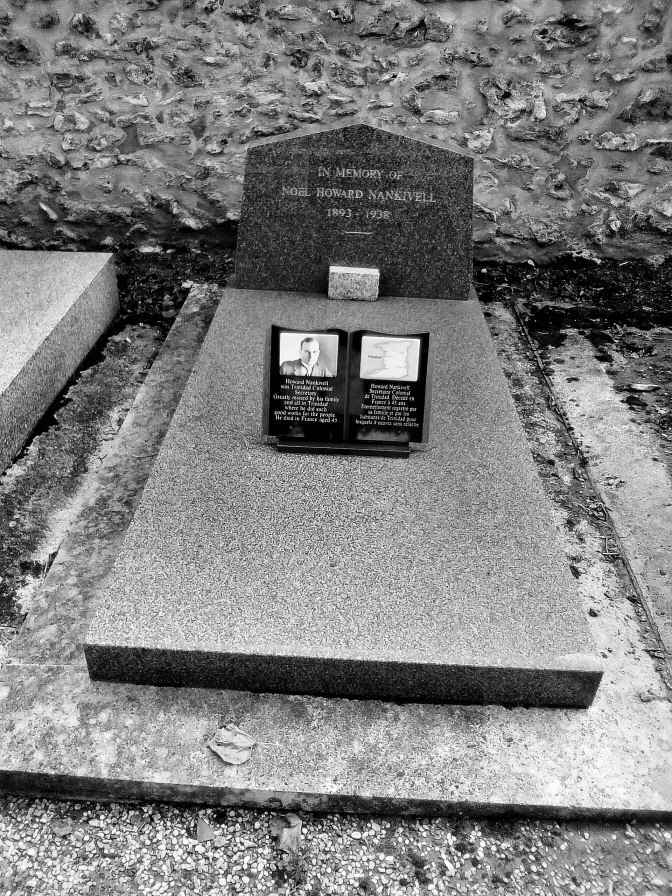 |
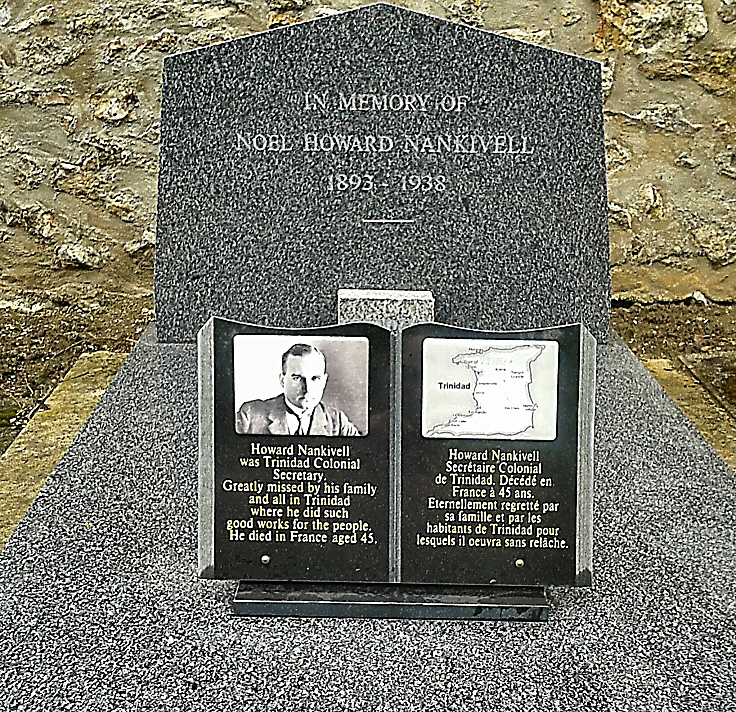 |
Some Cornish people still regard Cornwall, not as an English county, but as a British county called Kernow !
The "wall" part of the name, just as with "Wales" refers to the Saxon subtitle for them as "foreigners"
Australian readers might be interested in the book "Australia's Little Cornwall" by Oswald Prior. In the 1980 re-print, in Chapter 13 "Industrial Unrest" it seems that miners in Moonta were to go on strike - this was around 1920. (Many Cornish went to Australia as miners of course). There is a meeting at which "Nankivell, the last speaker, wanted to know whether they could go on strike without waiting for permission from the Union HQ at Creswick...when they met again the reply was read out to them <Cannot authorize strike>". This is the only mention of "Nankivell" in the book - which first appeared in 1962.
In Moonta ("Australia's little Cornwall") there is even a Nankivell Park
which inludes a marble arch war memorial
to the 34 Nankivells who
fought with the Australian military in WW1: one died in action.
It is clear that quite a few Nankivells went from Cornwall to Moonta to work the mines.
And near Tumby Bay, just across Spencers Gulf from Moonta, South
Australie,
there is a Nankivell Road and a Nankivell Street.
Both the street and the
park are named after the Edward Nankivell (son of Edward and Ann) who
worked on the railways, Laura Nankivell tells us.
Left
and centre photos thanks to Judy Weggelaar.
On the right: Aidan Nankivell at Nankivell Park in 2011, this photo from his dad Rob Nankivell
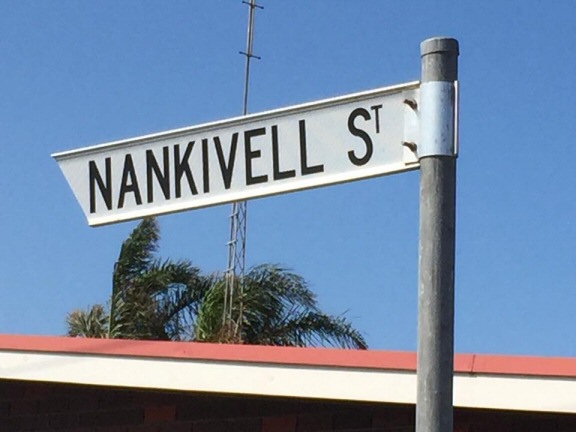 |
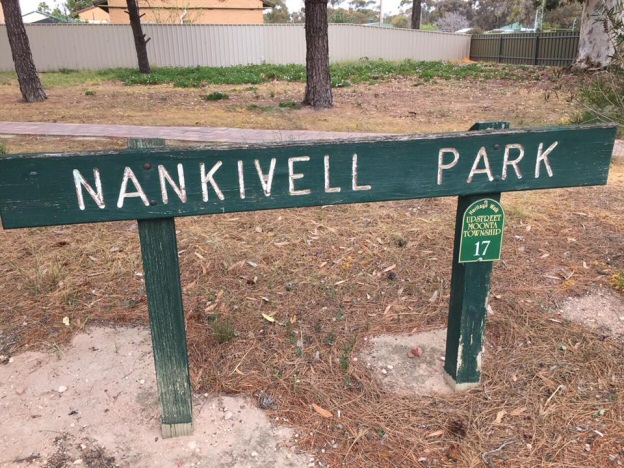 |
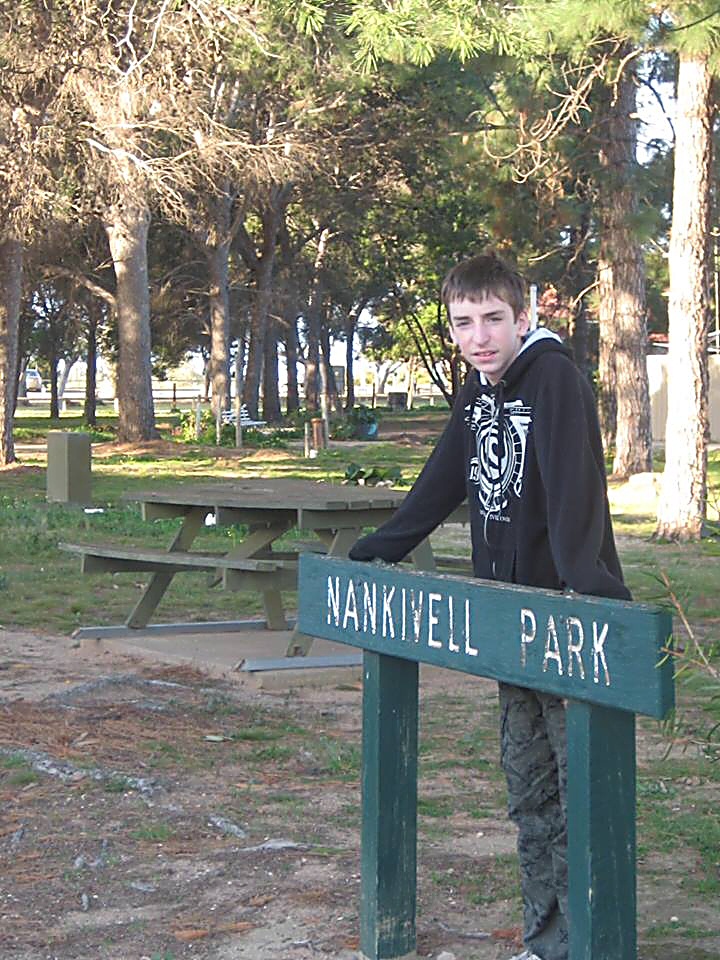 |
Another Australian/Cornish link is in Tasmania where there is a Tamar Valley with a Tamar River.
As is well-known, in Britain the
river Tamar divides Cornwall from Devon; it rises just under four miles
from the north coast to run all the way to the south coast.
Furthermore, one mile West of the middle-stage of Cornwalls River Tamar,
so
just inside Cornwall, is the town of Launceston.
And in Tasmania, at the head of its River Tamar, there is also a town named Launceston!
Still in Tasmania, in addition to the Tamar Valley Vineyards there is also the "Tamar Valley Dairy"
producing lovely dairy products.
Australia's "Most heroic woman" and "Most decorated woman" was Joice Mary Nankivell
(b.1887 in Queensland, Australia - died 1982 in Ouranoupoli, Greece). Her married name was
Joice NanKivell Loch. She was a very notable humanitarian
worker, also an author and journalist. In 1922 she published the
still-available book Ireland in Travail covering the rise of Sinn Fein 1910 to 1921 written by her with her soon-to-be-husband Sydney Loch. Then she did brilliant work
with the ethnic Greeks who were forced out of newly created Turkey and in fact
she died in the building in Ouranoupolis
from where her essential humanitarian work was carried out at a time
when Greece was in poverty and could not help the Greek refugees financially:- do read her
biographical book "Blue Ribbons Bitter Bread"
by Susanna de Vries ISBN 978-0-980216-0-0.
Joice Mary Nankivell had also worked wih refugees
in eastern Europe and one of her most daring efforts was to rescue more
than a 1000 Jewish women and children from the Nazis in Poland and
Romania.
Joice is related to Edmund Nankivell Jr (the author of this web page) and appears on his genealogical tree.
At her funeral in Greece in 1982 a Greek Orthodox Bishop named
her:-
"one of the most significant women of the 20th Century".
Another famous Nankivell is Reginald
Nankivell (1898–1977) - also known as Sir Rex Charembac Nan Kivell born and
educated in New Zealand, the illegitimate son of Alice Nankivell,
brought up by his grandparents George & Annie Nankivell. As a young
man with some money he came to England in 1919 to
join - in 1925 - the newly-formed Redfern Art Gallery, taking it over in 1931, and he made good money as an art dealer. He
collected books, periodicals, maps, paintings, prints artefacts etc from 1770 to
1900 mainly about the Australia, New Zealand and Pacific Ocean region including
the early history of Australian colonisation. He donated and sold about 5000
items to the Australian National Library, for which he was knighted. He evolved
his name to Sir Rex de Charembac Nan Kivell KCMG seeing himself as very
European. He also made significant donations to the relevant New Zealand archive.
To contact Edmund Typpett Nankivell, the author of this web page:-
E-mail: <ed AT 54666976.xyz>
telephone: +44 (0)1273-843 457
Address:-
Penmellyn
6 Kymer Gardens
Hassocks, Sussex
BN6 8QZ
England
|Click here for Doug Mumma's Nankivell Notebook|
or click here for the NANKIVELL Facebook page
Wikipedia has this Nankivell page <https://en.wikipedia.org/wiki/Nankivell>
Go to <https://wikitree.com/genealogy/NANKIVELL> for Wikitree Nankivell genealogy -
several 100s of Nankivells are
listed, in Cornwall, Devon, Australia and New Zealand - the earliest is dated 1715
The "Find My Past" website <https://www.findmypast.co.uk/surname/nankivell> has this Nankivell section